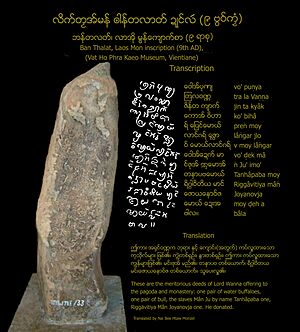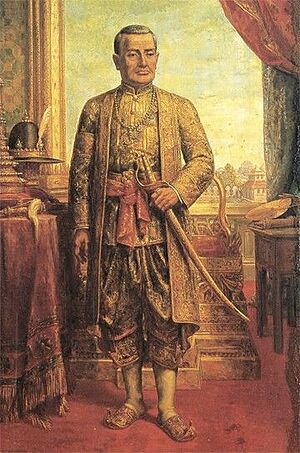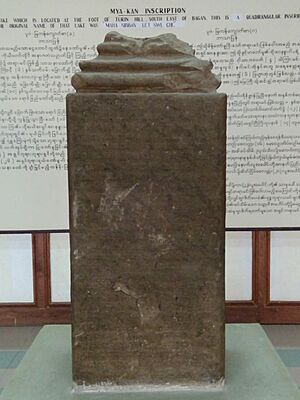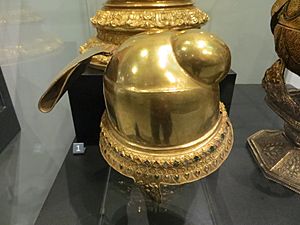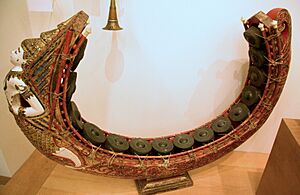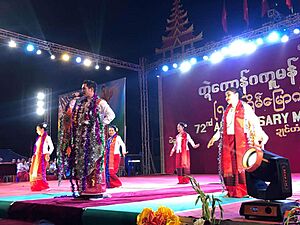Mon people facts for kids
| မန် | |
|---|---|
 |
|
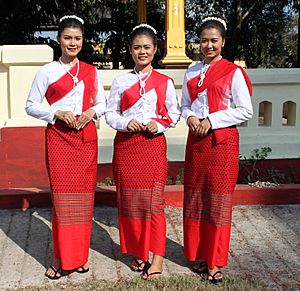
Mon girls wearing traditional dress in Mawlamyine
|
|
| Total population | |
| c. 1.7 million | |
| Regions with significant populations | |
| c. 1.1 million | |
| 200,000 | |
| 1,000 | |
| Languages | |
| Mon, Burmese, Thai | |
| Religion | |
| Theravada Buddhism, Mon folk religion | |
| Related ethnic groups | |
|
|
The Mon (Mon: မန်) are an ethnic group of people. They live mainly in Lower Myanmar and parts of Thailand. You can find them in places like Mon State and Bago Region in Myanmar. In Thailand, many Mon people live in Pathum Thani province and Phra Pradaeng.
The Mon people speak the Mon language. This language is part of the Monic branch of the Mon-Khmer language family. It is related to the Nyah Kur language spoken in Northeastern Thailand. The Mon language has also influenced other languages in Southeast Asia.
The Mon were among the first people to live in Southeast Asia. They helped spread Theravada Buddhism across the region. Many important cities today, like Yangon in Myanmar and Bangkok in Thailand, were founded by Mon people or their rulers. The Mon are known for sharing their culture throughout Southeast Asia.
Today, the Mon are a major ethnic group in Myanmar. They are a smaller ethnic group in Thailand. Mon people from Myanmar are called Burmese Mon. Those from Thailand are called Thai Mon. Their dialects are similar enough for them to understand each other.
Contents
What Does "Mon" Mean?
In the Burmese language, the word Mon (spelt မွန်) is used. This word means "Noble" in Burmese. In the Mon language itself, the Mon people are also called Mon (spelt မန်). This name comes from the Pali word Rāmañña, which refers to the Mon homeland along the coast of Myanmar. In old Mon writings, they were known as the Raman (ရာမန်).
The Mon people in Myanmar are divided into three main groups. These groups are based on the areas their ancestors came from in Lower Myanmar. They are the Mon Nya from the west, Mon Tang from the central region, and Mon Teh from the southeast.
Mon History
Ancient Times
Around 3,000–2,000 BCE, the ancestors of the Mon people began to move. They likely came from the Yangtze River valley in Southern China. They traveled south along major rivers like the Mekong and Irrawaddy. They brought with them the practice of farming near rivers, especially growing wet rice. Some Mon settlements reached as far south as the Malaya.
Early Kingdoms and Buddhism


The Mon are thought to be one of the oldest groups in Mainland Southeast Asia. They created some of the first civilizations there. These included Dvaravati in Central Thailand, Sri Gotapura in Laos, Hariphunchai Kingdom in Northern Thailand, and the Thaton Kingdom in Lower Burma.
The Mon were the first to welcome Theravada Buddhist teachers from Sri Lanka. They adopted the Pallava alphabet, and the oldest form of the Mon script was found in a cave in Thailand, dating back to around 550 CE.
Around the late 7th century, a kingdom called Lavo (modern Lopburi) grew in power. A famous queen named Camadevi from the Chao Phaya River Valley became the first queen of the Hariphunchai kingdom around 750-800 CE.
After 1000 CE, the Mon faced challenges. People from the north called the Tai peoples migrated, and the Khmer empire invaded from the east. Many Dvaravati Mon people moved west to what is now Lower Myanmar. The Mon people in the Chao Phaya Valley almost disappeared, either by being killed, captured, or blending into new cultures. However, the Hariphunchai kingdom survived in northern Thailand.
In 1057 CE, King Anawrahta of the Pagan Kingdom conquered the Mon's Thaton Kingdom in Lower Burma. The Mon culture and Mon script were adopted by the Bamar (Burmans). For the first time, the Mon came under Bamar rule. Still, the Mon remained the majority in Lower Burma.
Meanwhile, the Mon's Hariphunchai Kingdom in northern Thailand thrived. In 1289, King Mangrai of the Lanna Kingdom conquered Hariphunchai. The Mon culture then blended into Lan Na culture. The Lan Na people adopted the Mon script and religion.
The Hanthawaddy Kingdom (13th to 15th Centuries)

In 1287, the Pagan Kingdom fell apart. A man named Wareru, whose mother was Mon, became king of the Mon people. He founded the Hanthawaddy Kingdom (1287–1539). This was a time of great wealth and culture for the Mon. King Rajathiraj (1383–1422) united the Mon and fought off invasions. The reigns of Queen Shin Sawbu (1453–1472) and King Dhammazedi (1472–1492) were peaceful and prosperous.
Conflicts and Migrations (16th to 17th Centuries)
In 1539, the Bamar king Tabinshwehti conquered Hanthawaddy. After his death, the Mon briefly gained freedom but were defeated again in 1551. The Bamar moved their capital to Pegu (Bago), which was a former Mon capital. For the next two centuries, the Mon in Lower Burma were under Bamar rule.
Lower Burma became a battleground between the Bamar, Thai, and Rakhine. Many Mon people were forced or chose to move to Ayutthaya (Siam, now Thailand). A Mon monk even became a chief advisor to the Siamese King Naresuan.
In 1599, the Bamar capital Pegu was attacked. Bamar power weakened, and the Mon briefly regained some control around Mottama. However, they soon came under Bamar rule again. The Mon rebelled in 1661, but the rebellion was stopped. Mon refugees were welcomed in western Siam by the Siamese king. The Mon then played a big role in Siam's military and politics.
Rebellions and New Beginnings (18th to 19th Centuries)
Bamar power declined in the early 1700s. The Mon rebelled in Bago in 1740 to bring back their Hanthawaddy Kingdom. With help from the French, they created an independent kingdom. But in 1757, the Bamar King Alaungpaya conquered it. Alaungpaya's army caused great suffering to the Mon people. This led to many Mon people moving to Siam (Thailand) and Lanna.
After the fall of Ayutthaya in 1767, two Mon descendants, Phraya Pichai and Phraya Chakri, helped King Taksin free Siam from Burmese rule. King Taksin himself had some Mon ancestry.
After Taksin's kingdom fell, Phraya Chakri became King Rama I in 1782. He founded the Chakri Dynasty that still rules Thailand today. Rama I's mother was Mon, and his queen, Amarindra, came from a wealthy Mon family who had moved to Siam. Rama I founded Bangkok City as the new capital. When many Mon people moved from Burma to Siam in 1814, Rama I's grandson, Prince Mongkut (later King Rama IV), personally welcomed them. The Chakri dynasty of Thailand today has partial Mon ancestry.
The Mon in Thailand settled in areas like Pak Kret and Phra Pradaeng. They built their own Buddhist temples. Over time, the Mon people became part of Siamese society and culture, but they still kept some of their traditions.
Modern Times (19th to 21st Centuries)
The British took control of Burma in a series of wars. This helped the Mon people survive in Southern Burma, as they had faced harsh treatment under Bamar rule. Many had sought safety in Thailand.
In 1947, Mon National Day was created. It celebrates the founding of Hanthawady, the last Mon Kingdom.
After Burma gained independence in 1948, the Mon sought to govern themselves. However, the government refused. Mon groups rebelled against the central government. In 1974, a partially self-governing Mon State was created. Resistance continued until 1995, when a ceasefire was agreed.
Today, the Mon are a major ethnic group in Myanmar and a smaller ethnic group in Thailand. Many ethnic Mon from Myanmar have moved to other countries. They can be found in the United States, Australia, Canada, and several European countries.
Mon Language
The Mon language belongs to the Monic group of the Austroasiatic languages. It is closely related to the Nyah Kur language. It is also more distantly related to Khmer and Vietnamese. The Mon writing system comes from Indic scripts. The Mon language is one of the oldest recorded languages in Mainland Southeast Asia.
Many languages in the region have been influenced by Mon. The Tai Tham alphabet and Burmese alphabet are based on the Mon script. The Tai Tham alphabet is used for languages in northern Thailand and Laos. The Burmese alphabet is used for Burmese language and other languages in Myanmar.
The Thai language has many words that came from the Mon language. The Burmese language has also borrowed many words from Mon. These words are often related to things like administration, architecture, clothing, food, and flowers.
Today, the Mon language is recognized in both Myanmar and Thailand. However, the number of Mon speakers has decreased. In 2010, UNESCO classified Mon as a "vulnerable" language.
Mon Culture
Symbol
The symbol of the Mon people is the hongsa (Mon: ဟံသာ). This is a mythical water bird, often shown as a swan. It is also known as hintha in Burmese or hong in Thai. The hongsa is the state symbol of Myanmar's Bago Region and Mon State, which are important Mon areas. It is also the city symbol of Pak Kret City in Thailand, a historic Mon settlement.
-
Hongsa (the symbol of Mon people)
Music
Mon culture includes special dances and musical instruments. Some instruments are the kyam (a "crocodile xylophone"), the la gyan hsaing gong chime, and the saung harp. Mon dances are often performed in theaters or villages. The music for these dances uses drums, gongs, flutes, guitars, harps, and violins.
Festivals
During the Songkran festival in Thailand, Mon people in Phra Pradaeng District hold unique traditional ceremonies. These include folklore performances. Other Mon festivals are Loi Khamod and Luknoo. There is also a Mon Floating Boat festival and a Hongsa and Centipede Parade festival.
Clothing
Mon women wear a traditional shawl called Sbai. In Mon language, it is known as Yat Toot. They wear it diagonally across their chest, covering one shoulder. This style helps to tell Mon women apart from other ethnic groups in Myanmar. Old pictures from the Dvaravati era show women wearing similar shawls. Mon people in Myanmar and Thailand today are descendants of the Dvaravati people.
Mon men in Myanmar wear clothes similar to the Bamar people. Those living in Thailand have adopted Thai style clothing. Mon clothing styles have changed over time due to their own traditions and influences from other cultures.
Cuisines
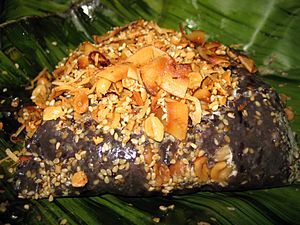
Mon cooking traditions have greatly influenced Burmese cuisine and Central Thai cuisine. Some popular dishes in Myanmar and Thailand were originally Mon dishes. Examples include Htamanè (ထမနဲ) in Myanmar, and Khanom chin and Khao chae in Thailand.
A traditional Mon dish is rice soaked in cool, candle-and-jasmine-scented water. Mon people eat this during the Thingyan (Songkran) Festival in the summer. In Thailand, this dish is called Khao chae (ข้าวแช่) and was once considered "royal cuisine." In Myanmar, it is known as Thingyan rice (သင်္ကြန်ထမင်း). Like other Southeast Asian cuisines, Mon cooking uses fermented fish seasoning.
-
Mon inspired Khao Khluk Kapi dish
Folk Games
Many games played in Myanmar and Thailand came from the Mon people. Some of the most famous Mon traditional children's games are Len Saba (a saba tossing game), Lor Kon Krok (Rolling a Mortar Bottom), and Mon Son Pa (Mon Hides a Cloth). These games are recognized as Intangible cultural heritage by UNESCO.
Thanaka
Famous Mon People
- Shin Arahan – A religious leader who helped spread Theravada Buddhism in Myanmar and Southeast Asia.
- Wareru – The founder of the Hanthawaddy Kingdom.
- Shin Sawbu – The only female ruler in the recorded history of Myanmar.
- Osoet Pegua – An important businesswoman in the Ayutthaya Kingdom in the 1600s.
- Taksin – The founder of the Thonburi Kingdom in Siam (Thailand).
- Rama I – The founder of the Chakri dynasty that rules Thailand today.
- Amarindra – Queen of King Rama I and mother of King Rama II.
- Chulalongkorn (Rama V) – The fifth king of the Chakri dynasty who modernized Thailand.
- Debsirindra – Queen of Rama IV and mother of Chulalongkorn.
- Sir J A Maung Gyi – A Governor of British Burma.
- Min Thu Wun – A famous writer and father of President Htin Kyaw.
- Htoo Ein Thin – A popular Myanmar pop singer.
- Palmy – A Thai pop singer.
- Nandar Hlaing – A Myanmar film actress.
- Chintara Sukapatana - A Thai film actress.
- Natapohn Tameeruks - A Thai film actress and model.
- Srirasmi Suwadee – A former princess of Thailand.
- Anand Panyarachun – A Prime Minister of Thailand.
- Myint Swe – A Vice-President of Myanmar.
Images for kids
-
Shwedagon Pagoda, an ancient Mon-style Stupa in Yangoon, Myanmar
-
Zinkyaik Pagoda, an ancient Mon-style Stupa on Zinkyaik Mountain, Mon State, Myanmar
-
The remains of an ancient walled town of the Hariphunchai Kingdom, Wiang Tha Kan, founded about 1,000 years ago in San Pa Tong District, Chiang Mai, Thailand.
-
Mon Hariphunchai-style architecture in Lampang, Thailand
-
Mon Hariphunchai-style architecture in Lamphun, Thailand
-
Ananda Temple, a mix of Mon and Indian architecture in Bagan, Myanmar
-
Mon-style architecture in Yangoon, Myanmar
-
The Golden Rock Stupa in Mon State, Myanmar
-
Hongsa pole with Centipede flag
See also
 In Spanish: Etnia mon para niños
In Spanish: Etnia mon para niños


